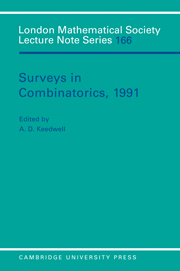Book contents
- Frontmatter
- Contents
- Preface
- “Radar Signal Patterns from Combinatorial Designs”
- “Old and New Results on Ovals of Finite Projective Planes”
- ”Schubert Polynomials“
- “Computational Methods in Design Theory”
- “Unprovable Combinatorial Statements”
- “Orientations and Edge Functions on Graphs”
- “Graph Perturbations”
- “A Graph Reconstructor's Manual”
- “Turán Type Problems”
”Schubert Polynomials“
Published online by Cambridge University Press: 05 September 2013
- Frontmatter
- Contents
- Preface
- “Radar Signal Patterns from Combinatorial Designs”
- “Old and New Results on Ovals of Finite Projective Planes”
- ”Schubert Polynomials“
- “Computational Methods in Design Theory”
- “Unprovable Combinatorial Statements”
- “Orientations and Edge Functions on Graphs”
- “Graph Perturbations”
- “A Graph Reconstructor's Manual”
- “Turán Type Problems”
Summary
INTRODUCTION
The theory of Schubert polynomials has its origins in algebraic geometry, and in particular in the enumerative geometry of the flag manifolds. The reader of this article will however detect no trace of geometry or reference to these origins. In recent years A. Lascoux and M.-P. Schiitzenberger have developed an elegant and purely combinatorial theory of Schubert polynomials in a long series of articles [L1]- [L3], [LS1]- [LS7]. It seems likely that this theory will prove to be a useful addition to the existing weaponry for attacking combinatorial problems relating to permutations and symmetric groups.
Most of the results expounded here occur somewhere in the publications of Lascoux and Schiitzenberger, though not always accompanied by proof, and I have not attempted to give chapter and verse at each point. For lack of space, many proofs have been omitted, especially in the earlier sections, but I hope I have retained enough to convey the flavour of the subject. Complete proofs will be found for example in [M2].
PERMUTATIONS
In this first section we shall review briefly, without proofs, some facts and notions relating to permutations that will be used later. Proofs may be found e.g. in [M2].
For each integer n ≥ 1, let Sn denote the symmetric group of degree n, namely the group of all permutations of the set [1, n] = {1,2,… n}. Each w ∈ Sn is a mapping of [1,n] onto itself; we shall write all mappings on the left of their arguments, so that the image of i ∈ [1, n] under w is w(i). We shall occasionally denote w by the sequence (w(1),…,w(n)).
- Type
- Chapter
- Information
- Surveys in Combinatorics, 1991 , pp. 73 - 100Publisher: Cambridge University PressPrint publication year: 1991
- 20
- Cited by

